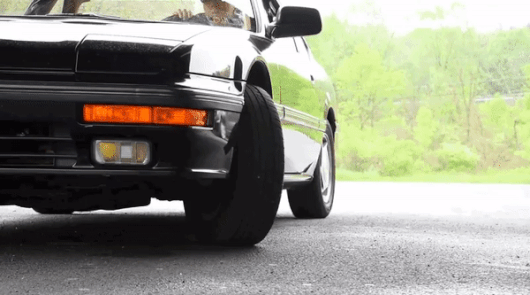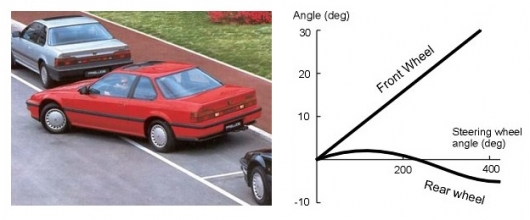In the 80-ies of the Honda already had a management system for all wheels
Honda Prelude 4WS model with a unique mechanical system to steer the rear wheels

No wonder the 80-ies of the steel to Japanese automakers a Golden age. Once in the United States and Europe understand how much you can get with a Japanese unique technologies and developments at dumping prices, so immediately began to invest in Japanese engineering. The mechanism was launched. The incredible development was another incredible one, and a trickle of investment ceased in deep river, filled all the high-tech industry. The Japanese, of course, was also not a loser. Come up with all sorts of unusual and interesting things for the domestic market. About the strange developments we have already mentioned, for example, in this article:
Why Japanese cars were staged side wipers?
Today, however, we are not going to cover the frankly weird design decisions and will focus attention on quite prophetic. For example, the system steer the rear wheel of the Honda Prelude 4WS. It is amazing that first appeared in the late ‘ 80s, that is for twenty-five years before similar versions began to be used among manufacturers of racing cars and luxury sports cars in Europe:

Despite a certain archaic (rear wheel drive was carried out in a mechanical way) and incredible by today’s standards, the angles of rotation of the wheels on the rear axle, the technology, the implementation and its history is worthy to be mention.
Very expensive, impractical, but absolutely amazing 4WS.
“4WS” – abbreviation is deciphered as “4 wheels steering”, that is, four driven wheels. Today such systems are produced for several purposes: 1 to improve the manageability and stability of the car at speeds; 2 Simplification of Parking.
Surprisingly, Honda is developing its system for the third generation model Prelude in the 87th year also pursued similar aims: on the one hand, to create a more comfortable environment for car Parking and ease of maneuvering on the narrow, crowded lanes of traffic (the rear axle is turned in the opposite direction relative to the front). Helped just the wildest angles of rotation of wheels of the rear axle.
It’s funny that the user issues a sports coupe Honda was that when the system is 4WS they couldn’t Park near the curb. The system was a disservice to the fact that you would almost not be able to drive close to the curb stone, and if by some miracle it managed to do is to sail back home would also be difficult – the car was up against the rear wheels are turned in the obstacle and stubbornly didn’t want to move.
On the other hand, the system doing high-speed cornering safer (turning the rear wheels in the same direction as front).
Here, the system worked similarly to modern analogs: at speed the rear wheels turned in the same direction as the front, “wineva” the car into a turn, reducing lateral displacement and reduces the risk of skidding.
By the way, there was a third reason – the variability of responsiveness of the car for taxiing. In slow city traffic the car into the turn faster and through a smaller number of turns of the steering wheel, whereas on the highway taxiing was not overly jerky and abrupt, adapting to the needs of the driver.
Alas, the Golden age soon passed, but problems remain. It is worth to note that despite the fairly reliable (as possible for such a refined variation of the control of all wheels), relatively easy and really intelligent design, the main problem was the high price. In the eighties to equip the car with the steering of the rear wheels from the factory can be had for 1.500 dollars is a very expensive fee for manufacturability and reducing the turning radius:

However, the backlash and the requirements for configuring convergence-collapse is also not added to the Treasury of the fans of exotic coins. Later, in the next iteration of system development, the problems added to failing electronic sensors that monitors the ratio of rotation angles of the rear wheels.
How the system worked-steer wheels Honda 4WS?
Interestingly, the system was completely mechanical, and it looks more reminiscent of the AWD system. Components included shaft drive (something like a small driveshaft) to the box under the Constitution, reminiscent of the rear differential on a conventional rear-wheel drive car. This box came out of an Axel, or rather a shaft of selection the capacities which pushed the rear tie rods going directly to the wheels. So all this machinery is operated by the wheels of the rear axle.

Few realized the meaning of all this at the time, so as soon as Japan lost its “endless” supply of cash to maintain its high-tech aspirations, the economic bubble burst, and the Country of the rising sun in 1991, has known one of the most severe economic collapse since its defeat in world war II. All this technological sophisticated self-indulgence quickly disappeared. However, as yet, well it was. Alas, a fairy tale, no happy ending.
